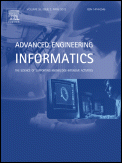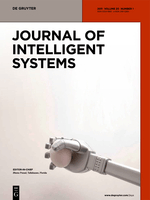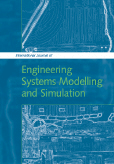
ADVANCED ENGINEERING INFORMATICS
Scope & Guideline
Leading the Charge in Interdisciplinary Research
Introduction
Aims and Scopes
- Advanced Computational Methods:
The journal emphasizes the development and application of advanced computational techniques, including machine learning, deep learning, and data mining, to solve complex engineering problems. - Digital Twin Technologies:
Research involving digital twin frameworks is a core focus, exploring how digital representations of physical systems can optimize design, monitor performance, and enhance predictive maintenance. - Human-Machine Collaboration:
The integration of human factors and machine learning in collaborative environments is highlighted, aiming to improve safety, efficiency, and productivity in engineering tasks. - Sustainable Engineering Practices:
The journal promotes research that addresses sustainability in engineering through innovative design, resource management, and lifecycle analysis. - Smart Manufacturing and Industry 4.0:
Papers often discuss the implications of Industry 4.0 technologies, including IoT, robotics, and cyber-physical systems, on manufacturing processes and operational efficiency. - Data-Driven Decision Making:
The application of data analytics for informed decision-making in engineering contexts is a recurring theme, with research focusing on predictive models and optimization techniques.
Trending and Emerging
- AI and Machine Learning Innovations:
A significant increase in papers employing cutting-edge AI methodologies, including generative models and reinforcement learning, showcases the journal's alignment with current technological trends. - Integration of Augmented and Virtual Reality:
Research integrating AR and VR technologies in engineering applications is on the rise, particularly in training and design processes, highlighting the importance of immersive technologies. - Advanced Data Analytics for Predictive Maintenance:
There is a growing emphasis on leveraging big data analytics and AI for predictive maintenance solutions, reflecting industry demands for efficiency and reliability. - Cyber-Physical Systems and IoT:
The emergence of research focusing on cyber-physical systems and the Internet of Things (IoT) indicates a trend towards interconnected systems and smart environments in engineering. - Sustainable and Circular Economy Practices:
An increasing number of papers addressing sustainability and circular economy principles in engineering design and manufacturing processes demonstrate a shift towards environmentally conscious engineering.
Declining or Waning
- Traditional Manufacturing Processes:
Research specifically focused on conventional manufacturing techniques has decreased, possibly due to the shift towards more automated and intelligent systems. - Manual Inspection Techniques:
There has been a decline in papers discussing manual inspection methods as the field increasingly adopts automated and AI-driven inspection technologies. - Basic Machine Learning Applications:
Papers that cover fundamental machine learning applications without advanced methodologies or innovative approaches are less frequently published, indicating a push towards more sophisticated techniques. - Regulatory Compliance in Isolation:
Research focusing solely on regulatory compliance without integration into broader technological frameworks appears to be waning, as interdisciplinary approaches become more favored.
Similar Journals

SOFT COMPUTING
Fostering Interdisciplinary Collaboration for a Smarter FutureSOFT COMPUTING is a premier international journal published by Springer, focusing on the interdisciplinary field of soft computing, which includes areas such as fuzzy logic, neural networks, genetic algorithms, and their applications. With an ISSN of 1432-7643 and E-ISSN 1433-7479, the journal is based in Germany and contributes significantly to the advancement of knowledge in its fields, boasting an impressive Scopus ranking that places it in the top echelons of Geometry and Topology, Theoretical Computer Science, and Software categories. In the 2023 category quartiles, it has achieved Q2 rankings in multiple disciplines, reflecting its high-quality research contributions. Though not Open Access, the journal's rigor and relevance to contemporary issues make it a favored resource for researchers, professionals, and students alike. From its inception in 2000 and spanning across the years until 2024, SOFT COMPUTING continues to serve as a robust platform for innovative research and theoretical advancements, making it an essential read for anyone engaged in the rapidly evolving landscape of computational intelligence.

Engineering Journal-Thailand
Pioneering new frontiers in engineering scholarship.Engineering Journal-Thailand, published by Chulalongkorn University, Faculty of Engineering, is a prominent academic journal dedicated to advancing knowledge and research in the diverse field of engineering. With an ISSN of 0125-8281 and an unwavering commitment to quality, the journal has established a substantial presence in the academic community since its inception in 2009. As of 2023, it is ranked in the Q3 category for Engineering (miscellaneous) and has achieved a Scopus rank of 137 out of 307, placing it in the 55th percentile of general engineering journals. Although it operates without open access, its impact within the engineering domain is significant, providing a vital platform for researchers, professionals, and students to disseminate their findings and engage with contemporary engineering challenges. The journal serves as a vital resource for those seeking to stay at the forefront of engineering innovation and contributes to the global discourse by bridging local insights with international perspectives.

Machines
Advancing the frontiers of engineering and computer science.Machines is a leading journal in the fields of engineering and computer science, published by MDPI in Switzerland since 2013. As an Open Access publication, it ensures that researchers, professionals, and students can freely access high-quality peer-reviewed research. The journal covers a diverse range of topics, including control and optimization, mechanical engineering, electrical engineering, and industrial manufacturing, boasting impressive rankings in various Scopus categories, such as Q2 in Computer Science and Control Systems Engineering. With a commitment to advancing knowledge and innovation in these critical areas, Machines serves as an essential platform for disseminating research findings and fostering collaboration within the academic community. By contributing to the ongoing dialogue in these dynamic fields, the journal plays a pivotal role in shaping the future of technology and engineering practices.

Journal of Intelligent Systems
Diving Deep into Intelligent Systems and SolutionsThe Journal of Intelligent Systems, published by DE GRUYTER POLAND SP Z O O, is a premier open access journal that has been at the forefront of advancements in the fields of Artificial Intelligence, Information Systems, and Software Engineering since its inception in 1991. With a commitment to disseminating high-quality research, the journal has been recognized in the 2023 category quartiles as Q3 in these critical areas, reflecting its relevance and impact in the academic community. The journal serves as a vital platform for researchers, professionals, and students interested in the evolving landscape of intelligent systems, offering insights into innovative methodologies and applications. As an open access publication since 2020, it ensures that research is readily available to a global audience, fostering collaboration and engagement within the scientific community. With a Scopus rank in the 65th to 69th percentiles across its categories, The Journal of Intelligent Systems continues to contribute significantly to the discourse on intelligent technologies and their implications for the future.

Studies in Informatics and Control
Pioneering Studies in Interdisciplinary EngineeringStudies in Informatics and Control is a distinguished academic journal published by the NATL INST R&D INFORMATICS-ICI, specializing in the interdisciplinary fields of Computer Science and Electrical and Electronic Engineering. With an ISSN of 1220-1766 and a recognized standing within its field, this journal aims to foster innovation and disseminate high-quality research findings from 2010 through 2024. It maintains a significant presence in the academic landscape, holding a Q3 ranking in both Computer Science (miscellaneous) and Electrical and Electronic Engineering categories for 2023, which underscores its commitment to advancing knowledge and technology in these areas. While the journal is not open access, it provides valuable insights and results that are essential for researchers, professionals, and students striving to develop their expertise in informatics and control systems. Based in Romania, its contributions traverse international boundaries, appealing to a global audience keen on the latest developments and trends within these rapidly evolving fields.

DATA & KNOWLEDGE ENGINEERING
Leading the Charge in Data Management ExcellenceData & Knowledge Engineering is a prestigious, peer-reviewed journal dedicated to the fields of data management, information systems, and knowledge engineering. Published by Elsevier in the Netherlands, this journal serves as a critical resource for researchers, professionals, and students alike, offering a platform for high-quality, original research and innovative approaches in the realm of data-driven technologies and methodologies. With a considerable impact factor and classified in the Q2 quartile for Information Systems and Management, it ranks 47th out of 148 journals in its category, placing it in the esteemed 68th percentile according to Scopus metrics. Data & Knowledge Engineering covers a wide array of topics including database systems, data mining, and knowledge representation, ensuring that it remains at the forefront of advancing understanding and application in these dynamic fields. Engage with compelling articles and significant findings published since its inception in 1985, as the journal continues to shape the future of data-centric research up to 2024 and beyond.

AI EDAM-ARTIFICIAL INTELLIGENCE FOR ENGINEERING DESIGN ANALYSIS AND MANUFACTURING
Exploring New Frontiers in Engineering with Artificial IntelligenceWelcome to AI EDAM - ARTIFICIAL INTELLIGENCE FOR ENGINEERING DESIGN ANALYSIS AND MANUFACTURING, a leading journal published by Cambridge University Press. This esteemed journal focuses on innovative research at the intersection of artificial intelligence and engineering design, analysis, and manufacturing, making it an essential resource for academics, industry professionals, and students alike. With an ISSN of 0890-0604 and an E-ISSN of 1469-1760, AI EDAM has established itself within the academic community, reflected in its impressive Scopus rankings: a Q3 journal in Artificial Intelligence and a Q2 journal in Industrial and Manufacturing Engineering. Covering years from 1987 to 2024, this journal emphasizes the rapidly evolving nature of engineering practices influenced by AI technologies. With robust contributions to the fields of engineering and computer science, AI EDAM serves as a crucial platform for disseminating scholarly work that fosters advancements in design and manufacturing methodologies.

Intelligent Medicine
Advancing medical practice with cutting-edge AI research.Intelligent Medicine, published by Elsevier, is a leading open-access journal dedicated to advancing the fields of Artificial Intelligence, Biomedical Engineering, Health Informatics, and related areas within Medicine. Since its inception in 2021, it has quickly established itself among the top tier of academic publications, holding a commendable Q2 ranking in several categories, including a rank of #51 in Health Informatics and #104 in Medicine (Miscellaneous) as of 2023. The journal aims to disseminate innovative research that harnesses AI technologies to improve healthcare outcomes, bridging the gap between cutting-edge technology and medical practice. With its open-access model, Intelligent Medicine ensures broad dissemination of research findings, facilitating collaboration and knowledge sharing among researchers, practitioners, and students globally. Located in Amsterdam, Netherlands, this journal plays a pivotal role in shaping the future of intelligent healthcare solutions, inviting submissions that push the boundaries of conventional medicine through creative and impactful research.

International Journal of Engineering Systems Modelling and SImulation
Connecting Researchers to the Cutting Edge of Systems ModellingInternational Journal of Engineering Systems Modelling and Simulation, published by InderScience Enterprises Ltd, serves as a pivotal platform for sharing innovative research in the fields of engineering and simulation methodologies. With a focus on bridging theoretical frameworks and practical applications, this journal holds a notable position within the academic community, as evidenced by its Q3 ranking in Engineering and Q4 ranking in Modeling and Simulation categories in 2023. The journal is indexed in Scopus, spanning critical advancements from 2008 to 2024, thus ensuring that researchers and practitioners remain at the forefront of evolving technologies and methodologies. While lacking Open Access options, it continues to engage readers with its compelling content, addressing complex systems engineering challenges and fostering interdisciplinary collaboration essential for the development of sustainable and efficient engineering solutions. This journal is vital for academics, engineers, and students looking to contribute to and learn from emerging trends in systems modeling and engineering simulation.

COMPUTER-AIDED CIVIL AND INFRASTRUCTURE ENGINEERING
Advancing the Future of Infrastructure EngineeringCOMPUTER-AIDED CIVIL AND INFRASTRUCTURE ENGINEERING, published by WILEY, stands as a leading journal in the domains of civil and structural engineering, computational theory, and computer-aided design since its inception in 1986. With an impressive ISSN of 1093-9687 and E-ISSN of 1467-8667, this esteemed UK-based journal holds a prestigious position in the academic community, reflected by its Q1 ranking in numerous relevant categories, including Civil and Structural Engineering and Computer Graphics as of 2023. The journal is renowned for promoting innovative research that utilizes computational techniques to solve complex engineering problems, making it an essential resource for researchers, professionals, and students alike. Despite its lack of open access options, the journal garners significant interest due to its rigorous peer-review process and high-impact articles, underlining its importance in the advancement of infrastructure engineering practices and technologies. With a Scopus ranking placing it among the top journals in various engineering and computer science fields, COMPUTER-AIDED CIVIL AND INFRASTRUCTURE ENGINEERING continues to foster knowledge and collaboration, ultimately contributing to the future of smart and resilient infrastructure development.